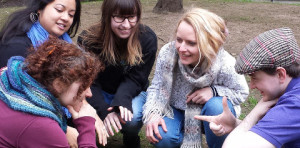What do you mean, based on a game?
“On the poster, it says the show is based on a game. Do you mean it’s like those crappy movies that are based on video games?”
No, not at all. Not even a little bit.
Dreaming is based on a story game. Story games are played around a table and – rather than a game – could perhaps be described as an activity that helps a group of collaborators create a story together that none of them would have created on their own.
Part theatre improv, part roleplay, part board game – story games provide a structure and rules by which a group can create a particular type of story. There are hundreds of these games out there, covering genres as diverse as horror, romance, crime, noir, supernatural, spy, adventure, sf and fantasy. They’re intended as an activity that – like a board game – can simply be enjoyed with others. But each game is also a tool with which two or three or more creators can work together to create something new.
My history with story games goes back to when I was developing the Studio programme for KDC. The Studio Pieces were a series of devised plays in which – in the time that the other shows were learning their lines and their blocking – the actors and I created our play from scratch. Setting, premise, characters, script, everything. And then learnt it and then performed it.
I’m proud of the plays that came out of that programme, but without a doubt having ten or more people all trying to create a single play at the same time had its difficulties. Generating ideas is easy, the group is never short of ideas, the challenge is focus, the challenge is how we say ‘no’.
I wanted an approach that allowed the actors to inspire each other, rather than overrule each other. I wanted everyone to be able – to be required even – to contribute and for that contribution to stay in place as the group built upon it. I wanted an approach through which the actors would be surprised by what they themselves came up with. And I wanted everyone to feel safe and comfortable with the story that we created. This is an approach I found in story games.
I used techniques gleaned from gaming in my final years with the Studio programme and they proved even more imaginative and – importantly for me – even more collaborative than the years before.
It is with this background in mind that I met Allan Cariño at a story game design jam near London Bridge. He had brought this idea to make a game based around A Midsummer Night’s Dream. I jumped at the idea to help and he and I and a few others spent the subsequent four hours hammering out how it might work. We finished it up over the next few weeks, I’ve played it several times around a table and it works. Allan decided to title it What Fools These Mortals Be and there it might have ended.
Now this is not the first long-form improv show to use a story game for its structure. Not by a long chalk. Others have, years before, been similarly inspired as to how these games could be used in the theatre. But the first one I saw was thanks to Michael Such. Michael, an avid improviser and story gamer, had taken a story game in the road movie genre and converted it into a thirty minute long-form improv called Open Roads that was performed as part of the Nursery Originals programme at the Edric Theatre in 2015. It had three performances in its first run, I saw two of them – and coming out from that I could not help but wonder what other story games could be performed as a long-form improv in front of an audience. Of course, I thought of Allan’s game which was rooted in theatrical tradition in the first place. How perfect would it be to take that back and perform it as a show?
And that is where Dreaming on a Midsummer’s Night began.
Dreaming on a Midsummer’s Night performs at the Rosemary Branch Theatre on 22-26 March 2016. http://www.rosemarybranch.com/index.php/programme/82-dreaming-on-a-midsummer-s-night

